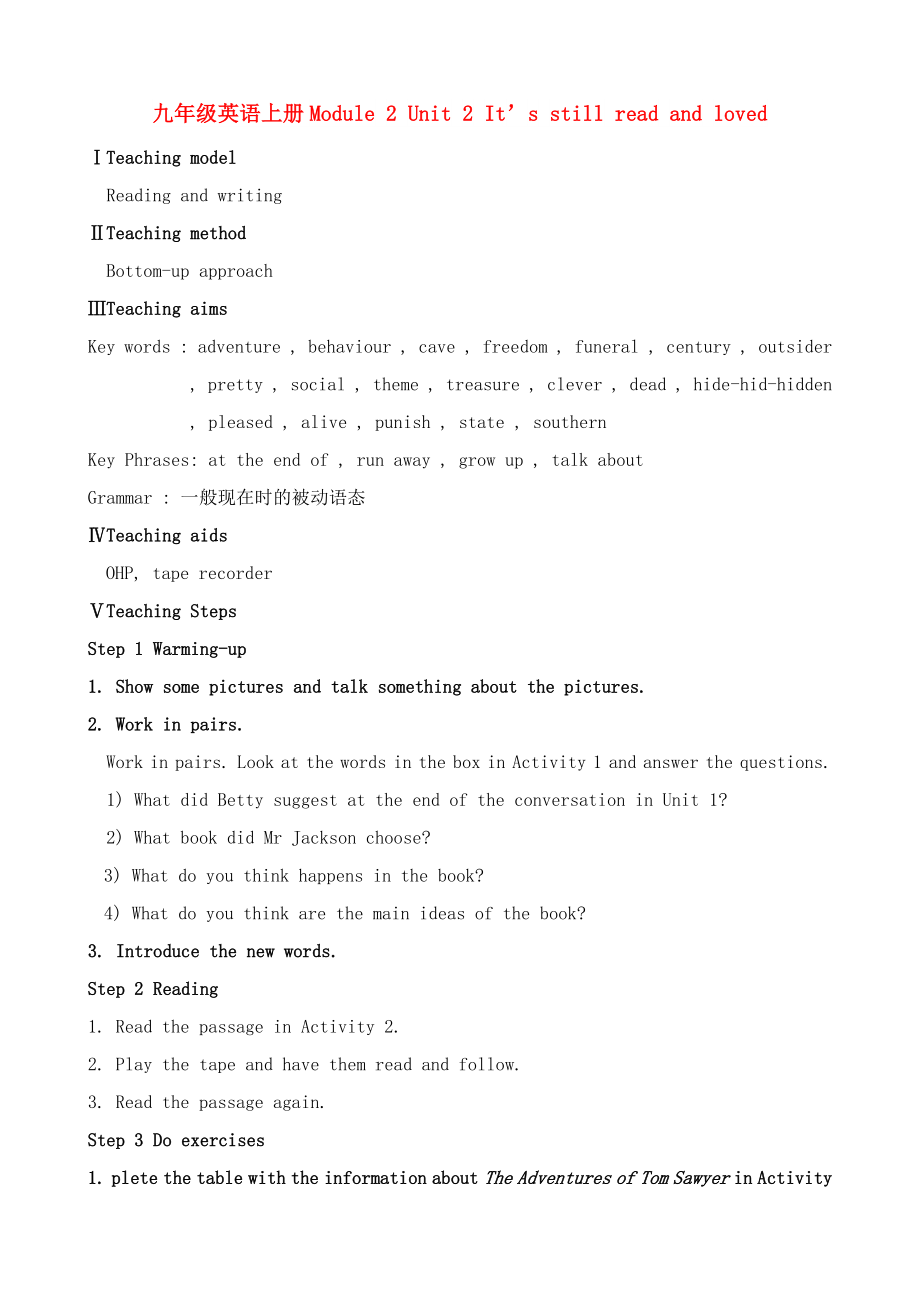《九年級英語上冊Module 2 Unit 2 It’s still read and loved》由會員分享����,可在線閱讀,更多相關(guān)《九年級英語上冊Module 2 Unit 2 It’s still read and loved(3頁珍藏版)》請在裝配圖網(wǎng)上搜索����。
1、九年級英語上冊Module 2 Unit 2 It’s still read and loved
ⅠTeaching model
Reading and writing
ⅡTeaching method
Bottom-up approach
ⅢTeaching aims
Key words : adventure , behaviour , cave , freedom , funeral , century , outsider , pretty , social , theme , treasure , clever , dead , hide-hid-hidden , ple
2����、ased , alive , punish , state , southern
Key Phrases: at the end of , run away , grow up , talk about
Grammar : 一般現(xiàn)在時的被動語態(tài)
ⅣTeaching aids
OHP, tape recorder
ⅤTeaching Steps
Step 1 Warming-up
1. Show some pictures and talk something about the pictures.
2. Work in pairs.
Work in pairs.
3、Look at the words in the box in Activity 1 and answer the questions.
1) What did Betty suggest at the end of the conversation in Unit 1?
2) What book did Mr Jackson choose?
3) What do you think happens in the book?
4) What do you think are the main ideas of the book?
3. Introduce the new words.
4����、
Step 2 Reading
1. Read the passage in Activity 2.
2. Play the tape and have them read and follow.
3. Read the passage again.
Step 3 Do exercises
1. plete the table with the information about The Adventures of Tom Sawyer in Activity 3.
2. Answer the questions in Activity 4.
1) What kind of b
5、oy is Tom?
2) Why do you think Tom wants to go to his own funeral?
3) Why do you think people still read Tom Sawyer?
4) Which of the scenes in the text do you like best?
Step 4 Explain the important and difficult points
1. The themes of the story are to do with children growing up and being mo
6����、re serious .故事的主題和孩子們的成長以及變得成熟穩(wěn)重有關(guān).be/have to do with sb. / sth.表示:“和某人/某事、有關(guān)”����。如:
My question has to do with yesterday's homework.我的問題和昨天的作業(yè)有關(guān)。
In the evening he likes to read books. These books have nothing to do with work.晚上他喜歡看書,這些書都與他的工作無關(guān).
2. Grammar:
英語的語態(tài)是通過動詞形式的變化表現(xiàn)出來的����。英語中有兩種語態(tài):主動語
7����、態(tài)和被動語態(tài)����。主動語態(tài)表示主語是動作的執(zhí)行者����。
例如:Many people speak Chinese.
謂語:speak的動作是由主語many people來執(zhí)行的。
被動語態(tài)表示主語是動作的承受者����,即行為動作的對象。例如:
Chinese is spoken by many people.主語English是動詞speak的承受者����。
被動語態(tài)由 “助動詞be+及物動詞的過去分詞”構(gòu)成。人稱����、數(shù)和時態(tài)的變化是通過be的變化表現(xiàn)出來的。一般現(xiàn)在時的被動語態(tài)構(gòu)成:am/is/are+p.p.(過去分詞)eg:
1) Shakespeare’s plays are seen by
8����、millions of people every year.
2) Confucius’ works are still read by many people today.
3) Mark Twain isn't known as a great thinker.
4) Parents are respected by Chinese people.
5) Many trees are planted along the two banks of the river.
3. Learning to learn
Step 5 Speaking and writing
1. W
9����、ork in pairs.
Would you like to read The Adventures of Tom Sawyer? Why/ Why not?
2. Think of your favourite great book or choose a book you'd like to read.
Use an encyclopaedia or the Internet to help you if necessary.
Now plete the table in Activity 3 with details about your favourite great book.
3. Write a passage about your favourite great book.
Use the passage in Activity 2 and your notes in Activity 6 to help you.
4. Work in pairs.
Talk about your favourite book.
Step6 Homework
Finish the exercises in the workbook Ex. 6, 7&8.
 九年級英語上冊Module 2 Unit 2 It’s still read and loved
九年級英語上冊Module 2 Unit 2 It’s still read and loved

